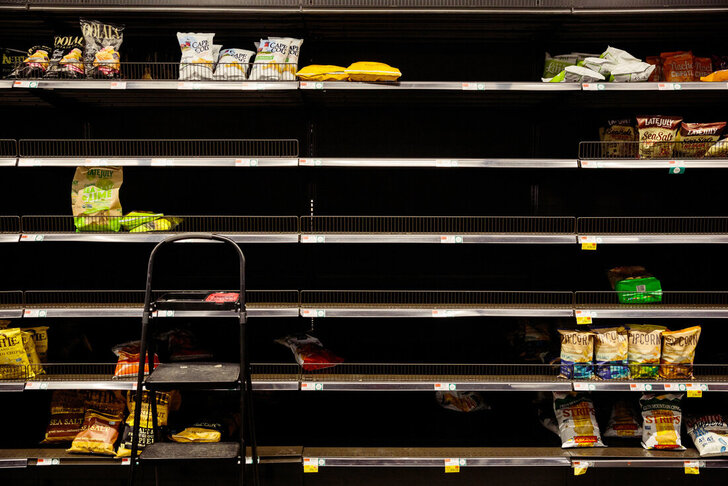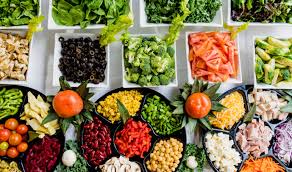|
While the world’s foremost politicians, celebrities, epidemiologists, and journalists are abuzz about the coronavirus pandemic, there’s another issue looming in the shadows. A “hunger pandemic,” warned the head of a United Nations food agency, is likely to bring “the worst humanitarian crisis since World War II.”
Before coronavirus controlled the news, you’ll recall that countries such as Lebanon, Yemen, Venezuela, Lebanon, and Syria were suffering from high rates of chronic hunger. In war-ravaged Yemen, 20 million people are food insecure and 3.2 million women and children suffer from acute malnutrition. Research from the UN’s World Food Programme (WFP) estimates that if the WFP cannot provide the life-saving assistance needed to the Yemenis, upwards of 300,000 people could starve to death every single day for a three month period. Additionally, many UN programs that assist impoverished Yemenis could shutter because of major cuts in US aid. Although the UN and other international bodies have taken steps to combat world hunger, the coronavirus pandemic has the power to stall or even reverse that progress. This worldwide increase in hunger is the result of a global economic recession. Loss of income, the decline in tourism, and the collapse of oil prices are all contributing factors. Due to schools being canceled, students around the world whose only guaranteed meals were from their school’s cafeteria are left hungry. It has long been predicted that countries that rely on food imports, especially the least developed countries, are the most at risk in a world food crisis. But it’s not only developing countries that the coronavirus is taking a toll on. The pandemic has caused a rise in food insecurity in the United States. In April, 20.5 million American jobs were lost, leaving millions of families not knowing how they were going to get their next meal. The most obvious solution – expanding the Supplemental Nutrition Assistance Program (SNAP) – was an option, but was hindered by a partisan divide. Democrats argued that investing in the food stamps program, one proven to decrease hunger levels, was a safe bet and would cost much less than the Coronavirus, Aid, Relief, and Economic Security (CARES) act, a $2 trillion stimulus bill to provide economic relief. Republicans, however, believe that Democrats are using the coronavirus to leverage a permanent expansion of the food stamps program and, by extension, the welfare state. Although the Trump administration has agreed to a short-term increase in food stamp benefits, this compromise leaves millions of Americans vulnerable to food insecurity in the coming months and beyond. While the world lies in wait for the nightmare of the coronavirus to end, there is always the possibility of a light at the end of the tunnel: the development of a vaccine by autumn, a miracle drug such as Remdesivir to help patients, and the possibility that social distancing works to flatten the curve so we can return to our normal lives. But for hundreds of millions across the globe, this nightmare has no end in sight as the hunger pandemic has the potential to continue on and worsen even after the coronavirus becomes a distant memory. Sources By Shreya Shivakumar
0 Comments
 Here are some simple gluten-free dessert recipes that are perfect for any occasion. Gluten-Free Blondies Recipe from Bon Appetit Ingredients:
Instructions:
Gluten-Free Fudgy Brownies Recipe from Delish Ingredients:
Instructions:
By: Sarina Thapar Over fifty million Americans have allergies and thirty-two million have food allergies. You probably know one of those people or are one yourself. But why does allergic reaction occur? An allergic reaction occurs when your immune system overreacts to a food or a substance in a food, thus identifying it as a danger and triggering a protective response. Symptoms of a food allergy can range from mild to severe, with the most severe allergic reaction being anaphylaxis. During an anaphylaxis shock, Epinephrine may be life-saving if administered to a person as quickly as possible. However, in minor cases, prescribed antihistamines such as diphenhydramine (Benadryl) may help reduce symptoms. What is the science behind an EpiPen? The first-line treatment for anaphylaxis is epinephrine (adrenaline). It is available by prescription in an auto-injector named EpiPen. Epinephrine works by reversing the symptoms of anaphylaxis. For example, when you inject an Epipen on the thigh, a person's blood pressure decreases during an anaphylactic reaction because the blood vessels relax and dilate however the epinephrine causes the blood vessels to constrict, thus raising blood pressure. Epinephrine is the synthetic form of the naturally occurring sympathomimetic amine with vasoconstricting (constriction of blood vessels thus raising blood pressure), intraocular pressure-reducing, and bronchodilating activities (An expansion of the air passages through the bronchi of the lungs). Additionally, Epinephrine elevates the blood sugar levels by increasing the hydrolysis of glycogen to glucose in the liver, and at the same time, it begins the breakdown of lipids in adipocytes (a cell specialized for the storage of fat). In all, Epinephrine has a suppressive effect on the immune system. What is the science behind antihistamines? Antihistamines reduce or block histamines, therefore they can stop allergy symptoms. It works well to relieve symptoms of different types of allergies, including seasonal, indoor, and food allergies. Antihistamines block H1 histamine receptors. They replace histamine at receptor sites (proteins that receive signals for a cell) at which it becomes bound in various susceptible tissues. Thus it prevents histamine-triggered reactions under conditions like food allergies. In terms of the difference between antihistamines and epinephrine, it is essential to note that epinephrine is not a long-term medication for allergies, and should not be a substitute for allergy medications like antihistamines. By: Vasundhara Kulkarni Around 32 million Americans are currently living with food allergies that can make everyday grocery shopping a difficult task. And with the onset of COVID-19 leaving store shelves across the nation devoid of most foods, the task of preparing food becomes even more dire for those who suffer from food allergies.
For those who have food allergies and other dietary restrictions, grocery shopping is not just a matter of picking the freshest or the yummiest ingredients on the shelves— it’s a serious matter of safety and health. In the most severe cases, it can be a matter of life and death. Anywhere from around 1 to 5% of Americans are believed to suffer from anaphylaxis, a severe allergic reaction that can cause potentially life-threatening effects within minutes of contact with an allergen. Other dietary restrictions such as the gluten-free diet required by those with celiac disease also require much more selectivity when it comes to purchasing food— selectivity that becomes difficult when shelves are empty due to increased buying from the ongoing coronavirus pandemic. COVID-19 has had especially devastating effects on our community in New Jersey. As of Friday, May 8th 2020, the state has seen over 130,000 confirmed cases and nearly 9,000 deaths due to the virus. Grocery stores have continued to witness overwhelming demand for products such as toilet paper, disinfectant, and produce, resulting in many stores instating a limit on purchases in order to fight hoarding. Luckily, there are ways to help. Lisa G. Gable, the CEO of the nonprofit Food Allergy Research & Education, recommended that shoppers without food allergies exercise caution when making choices about what to buy at the supermarket. She asked that shoppers consider others’ dietary restrictions when purchasing items like soy milk and gluten-free foods which are necessary for many who need to eat those to survive. For those with food allergies, Kids With Food Allergies recommends that families take greater precautions when cooking due to the newfound proximity of family members who may have different dietary restrictions. They also recommend shopping strategically by minimizing visits to the store and looking for local grocery delivery services. This will be a difficult fight, but working together as a community, we can get through this. Here at Nourish, we would like to ask everyone to be mindful of what they purchase and keep other shoppers in mind— especially those who may not have the luxury of eating whatever is left on the shelves. Though this pandemic presents uncharted territory for us as a nation, we strongly believe in the fight to overcome this challenge together. Remember to follow social distancing guidelines and stay safe everyone! By: Michelle Liu Introduction
When it comes to food allergies, pets are not too different from humans. Although they are less common, around 10% of dogs and 13% of cats have food allergies. The most common allergies in pets stem from beef, chicken, dairy, and fish. They could be caused by both genetic predispositions and environmental effects, especially if they were exposed to antibiotics at an early age. Pets cannot develop allergies for foods they have not been exposed to. As they are less common, many people do not know what to do when their pet has an allergic reaction to the food they eat, but worry not! Symptoms The most common symptoms for dogs include chronic ear inflammation, gastrointestinal problems (including diarrhea, constipation, and vomitting), and anal fissures or itches. Cats display many of the same symptoms, but are much more prone to itchy skin, which can lead to wounds. In less common pets such as hamsters or other rodents, violent bursts of sneezing has been observed. These symptoms occur almost immediately after the pet has eaten something that it should not have. They may sometimes subside on their own, but most likely require some form of medical attention. Treatment Options As with most people, allergies last for a lifetime in pets. The best options for relieving your pet of its allergies is to simply not feed them the food that makes them allergic, and avoid dog and cat food packets that may induce allergies. Making your pet go vegetarian is not recommended, as it deprives your pet of the essential nutrients it needs. If your dog or cat were to have an allergic reaction to any of the food it eats, be sure to give it the proper medication. Antihistamines (excluding OTC) are known to work especially well. Sentry and Petlab are renowned for their medications for pet allergies. If they are not available, most over the counter medicine in moderation is known to work as well. This includes Claritin, Benadryl, and Zyrtec. Avoid Tylenol and Ibuprofen, as they are not safe for pets. If the condition of your pet gets worse, be sure to visit your vet. Allergy Friendly Options There are many companies that provide allergy friendly pet food. With any pet food, however, make sure to read the labels and nutritional facts. Here are a few companies can try:
For more information on OTC medications for pet allergies, you can visit https://yourdogadvisor.com/otc-pain-meds-for-dogs/ By: Shravya Harish With National Decision Day having just passed on May 1, high school seniors across the country have now committed to their future colleges or universities. Naturally, these soon-to-be college students have been thinking about and planning how they will begin their college experience. With students with food allergies, however, this planning sometimes looks a little bit different. Nonetheless, with some extra caution and preparation, these students will be able to experience the full college experience with their peers.
By: Nami Jain |
Details
Archives
May 2021
Categories |
Powered by
 Create your own unique website with customizable templates.
Create your own unique website with customizable templates.
 Create your own unique website with customizable templates.
Create your own unique website with customizable templates.









 RSS Feed
RSS Feed